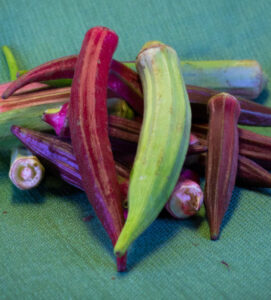Okra


Okra has been in cultivation throughout Africa and Asia for thousands of years. It made its way to the Americas through the enslavement of African people. According to folk history, okra was such an important food source that enslaved Africans smuggled okra into the Americas by sowing seeds into their clothes and hair. Since the crop grows well in hot weather and poor soil during drought conditions, it quickly became a staple food crop throughout the southern U.S. Thomas Jefferson noted that it was a well-established crop in Virginia in 1781, and it was abundant in Florida by 1800. Today, okra is grown and consumed throughout much of the world’s tropical and temperate regions, especially Asia and North America.





Okra is a hardy plant resistant to drought, excessive rain, and poor soil conditions. It is frost-sensitive, however, and seeds or transplants should be planted outside in the ground after the last frost (April to September.) sow seeds a few inches deep and one foot apart and harvest the pods June through October. Soaking the seeds for several hours just before planting should increase germination rates. (UF/IFAS). Harvest daily since pods will grow significantly throughout the day and turn woody quickly. To plan, a heritage garden, download the ‘Planning a Florida Heritage Garden (PDF).’

Santa Fe College Partnered with Multiple Organizations in a Collaborative Effort to Bring Awareness of the Heritage Plants In Florida.
BY CULTURAL HISTORY
BY GROWING SEASON
DROUGHT TOLERANT PLANTS
Commitment to Equal Access and Equal Opportunity
Santa Fe College is committed to an environment that embraces diversity, respects the rights of all individuals, is open and accessible, and is free of harassment and discrimination. For more information, visit sfcollege.edu/eaeo or contact equity.officer@sfcollege.edu.
SACSCOC Accreditation Statement
Santa Fe College is accredited by the Southern Association of Colleges and Schools Commission on Colleges (SACSCOC). For more information, visit sfcollege.edu/sacscoc.
